The Purpose of This Study
The goal of this study is to use data to capture trends in new play production at the seventy-five LORT (League of Resident Theatres) member theatres and the thirty-two NNPN (National New Play Network) core member theatres. In working, I set out to answer three questions: Who is being produced on our stages? What kinds of characters are appearing on our stages? And what do these plays look like in terms of form and thematic content? By measuring where new play production is currently at, I hope to create an awareness of not only what is happening on our stages but also what is missing from them.
The Study’s Methodology
I identified 111 titles that are receiving a world premiere at either a LORT or NNPN theatre in the 2019–20 season. I then emailed surveys about these plays to either the literary manager or artistic director at the theatres producing these titles. I received responses for 80 of these plays, giving the study an overall response rate of 72 percent.
When designing the study, I made several important choices. First, I decided not to include musicals. Because cast size was one of my interests, I felt that combining musicals and plays in a single study might skew the numbers and give the impression that the plays being produced utilize more actors than they actually do. And while I considered conducting a second study devoted exclusively to musicals, I ultimately came to the conclusion that there are not enough musicals being premiered at LORT and NNPN theatres this season to get a meaningful sample size.
Second, I chose to count each title only once regardless of whether or not the play was receiving a rolling world premiere. I made this decision because I felt that counting a title multiple times might give a single play too much weight in the final results. In addition, there wasn’t any clear way to differentiate in the data, for example, between three plays and one play receiving three productions as part of a rolling world premiere. Because of this, I decided the study’s findings would be clearer if I made the decision to count each title only once.
Third, when looking at cast composition, I focused only on the specifications made by the playwright and not the casting choices of an individual production. I did this because I wanted to explore whose narratives and experiences are finding their way to our stages and whose narratives and experiences remain absent. Thus, in my approach to representation and diversity, I chose to make a distinction between a race-neutral role played by a non-white actor and a role written specifically for a non-white actor. In retrospect, I wish the survey had also included an additional question about the number of race-neutral roles in the script. However the results presented below don’t account for those kinds of roles.
Finally, I should note that while the survey received 80 total responses, this doesn’t mean that each question received 80 responses. Whenever one uses broad categories for statistical purposes, there is a certain amount of nuance and case-by-case specificity that gets lost. The result is that some respondents omitted answers to certain questions because the framing language of the question didn’t always allow for an appropriate response. The clearest example of this can be found in the question devoted to each play’s central theme. This question, which had the lowest response rate, received only 63 responses.
First and most troubling is the almost total absence of trans and non-binary voices in this season’s offerings.
Who Is Being Produced?
The first thing I wanted to measure was demographic information about the playwrights themselves. I chose to look at gender identity, race, age, and educational attainment. Collectively, this data provides a broad overview of how opportunities are currently being distributed in the field.
- Playwrights by gender (part 1): 53.3 percent are women, 42.7 percent are men, 2.7 percent are multiple authors of different genders, and 1.3 percent identify as non-binary.
- Playwrights by gender (part 2): 100 percent are cisgender, 0 percent are transgender.
- Playwrights by race: 47.2 percent identify as white, 23.6 percent identify as African American, 12.5 percent identify as Latinx, 4.2 percent identify as Middle Eastern or Arab American, 2.8 percent identify as Indigenous, 2.8 percent identify as Asian or Asian American, 2.8 percent are multiple authors of different races, 2.8 percent identify as other, and 1.4 percent identify as multiracial.
- Playwrights by age: 47.9 percent are ages 26–40, 40.8 percent are ages 41–60, 9.9 percent are over age 60, and 1.4 percent are under age 26.
- Playwrights by educational attainment: 54.4 percent have an MFA in playwriting, 45.6 percent do not have an MFA in playwriting.

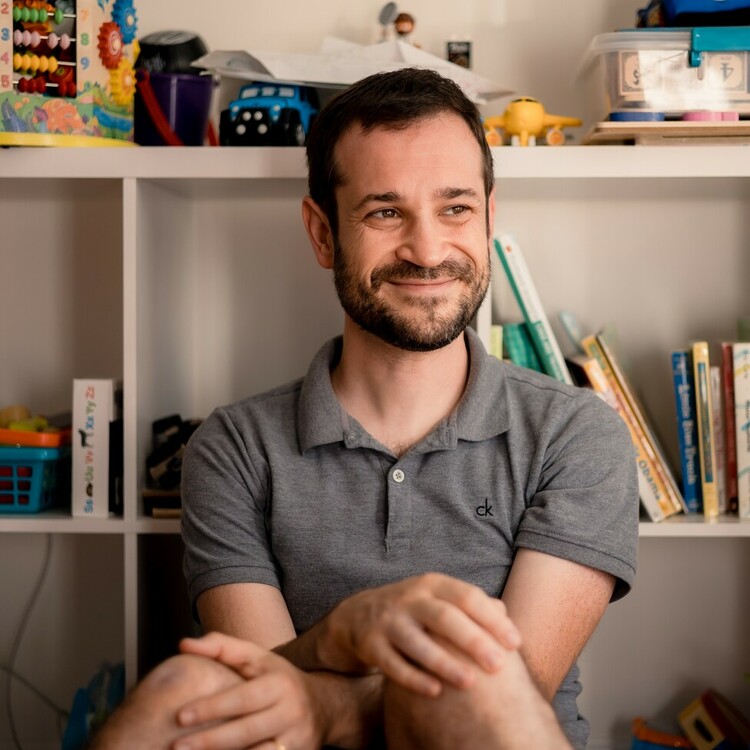
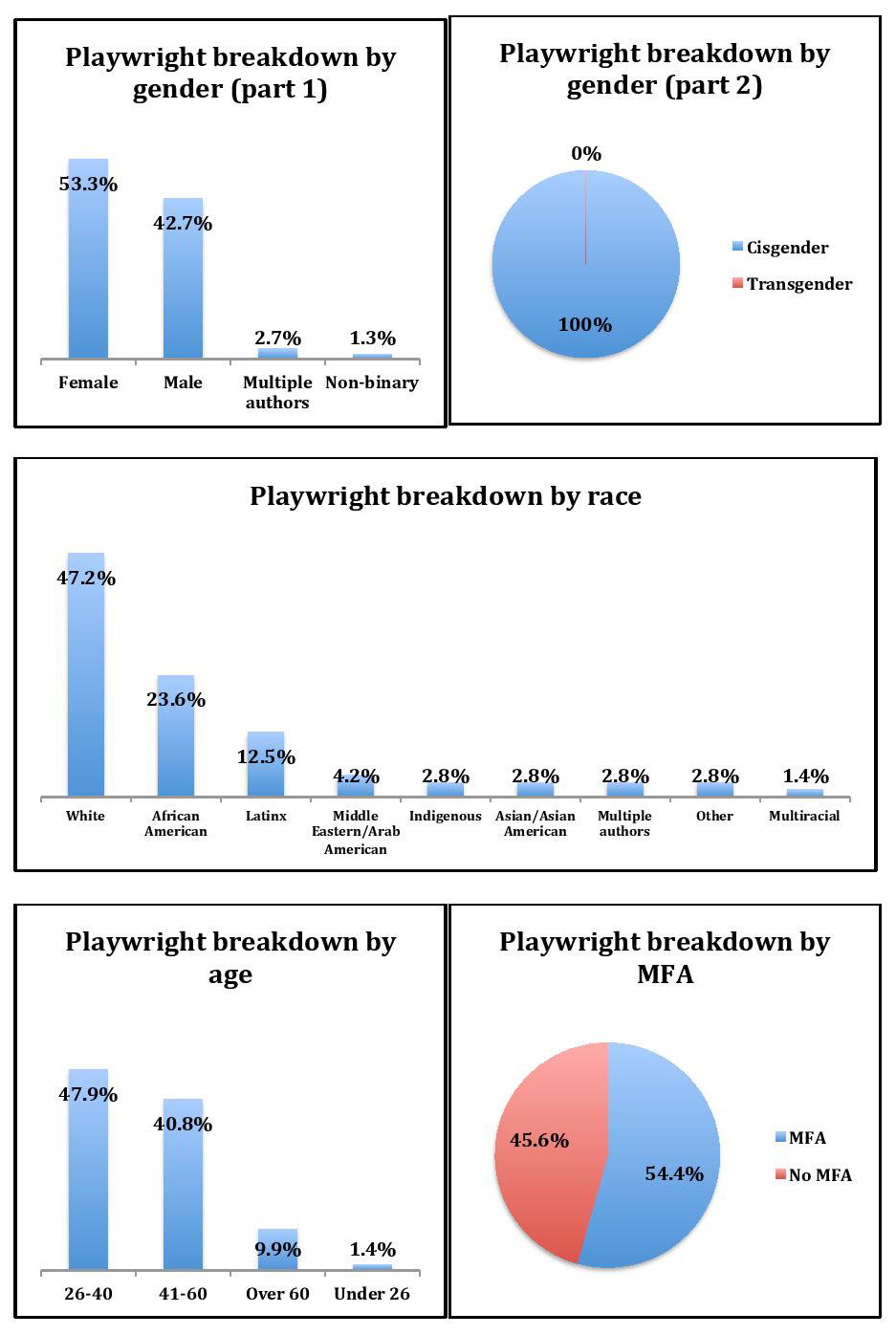
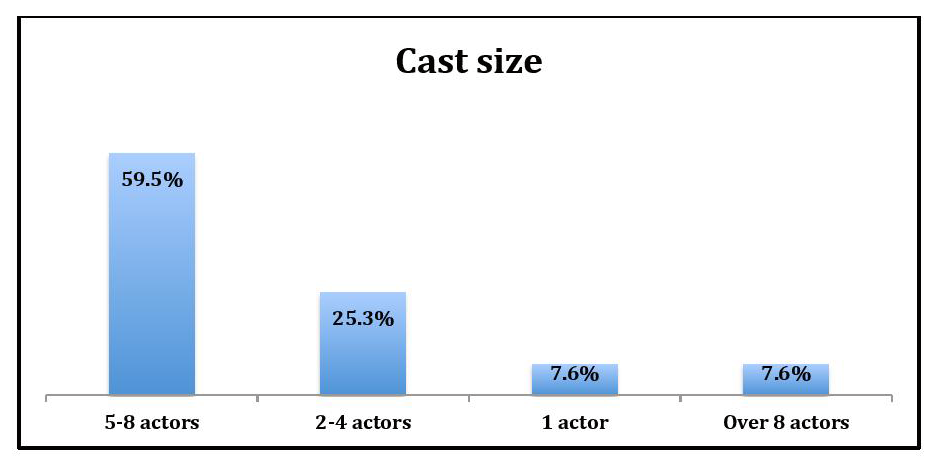
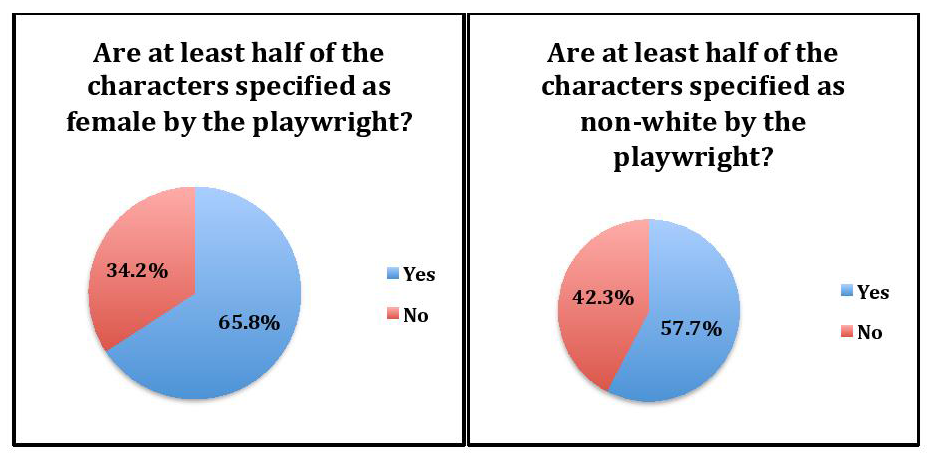
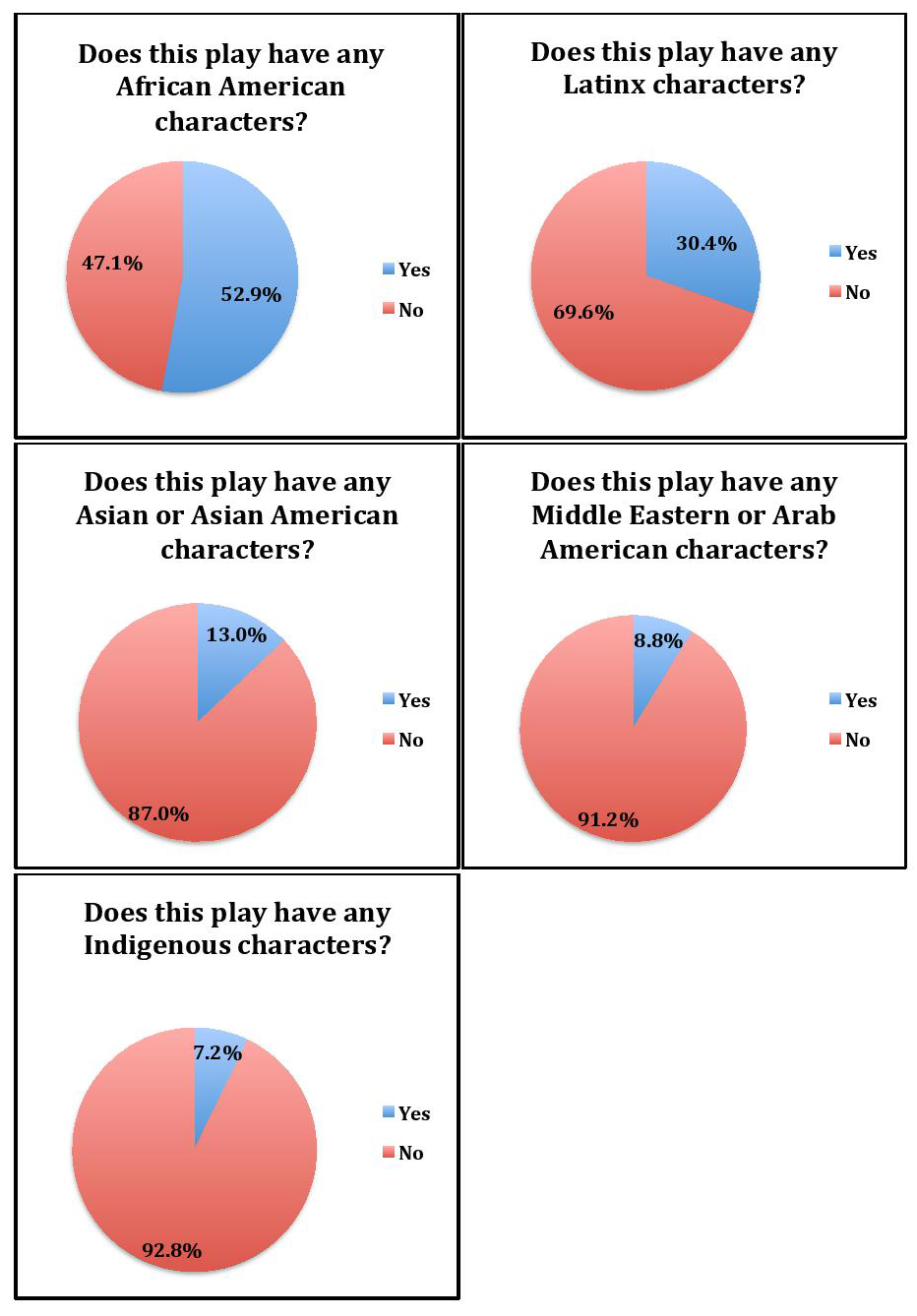

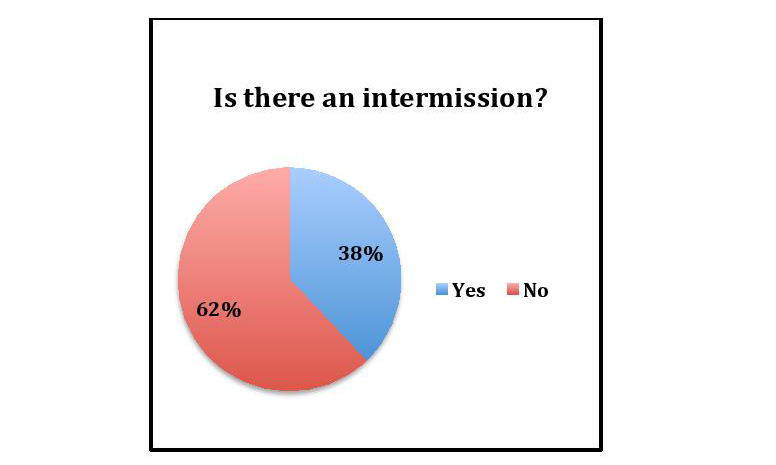
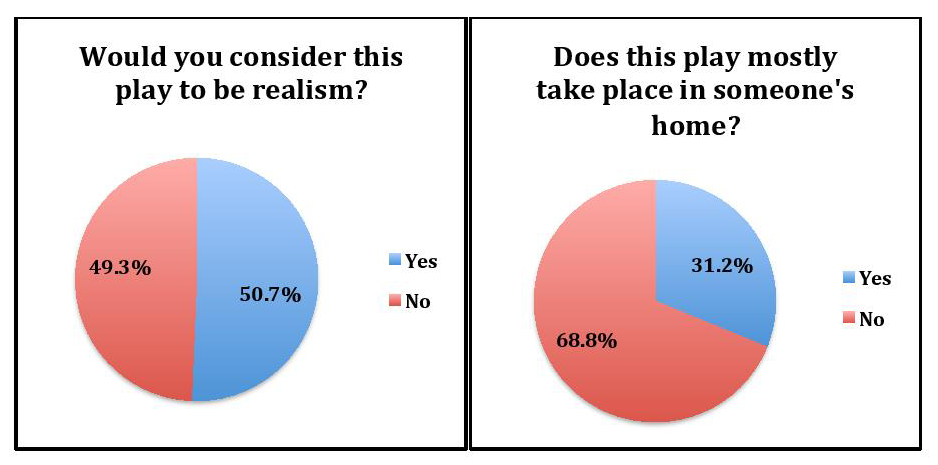

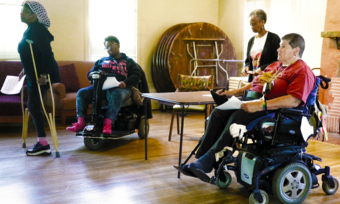

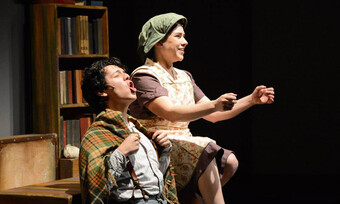

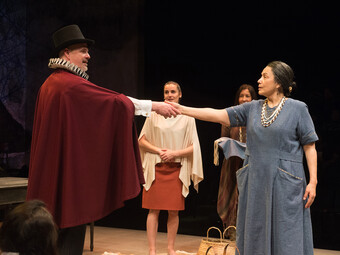

Comments
The article is just the start of the conversation—we want to know what you think about this subject, too! HowlRound is a space for knowledge-sharing, and we welcome spirited, thoughtful, and on-topic dialogue. Find our full comments policy here
Hi Marshall,
Would it be possible for you to share the 111 titles that were used for this survey?
Olivia, this is the list I worked from. Keep in mind that no musicals are on this list. Also, I only received responses for 80 of the 111 titles. Finally, I did not count rolling world premieres multiple times, so some of these titles are receiving additional world premieres at theaters other than the ones you see below.
List of Titles
ACT Theatre (Seattle): People of the Book
Alabama Shakespeare: Buzz
Alley Theatre: Amerikin
Alliance Theatre: 53% of
American Conservatory Theatre: Testmatch
Arden Theatre: My General Tubman
Arena Stage: Right to be Forgotten
Arena Stage: Celia and Fidel
Artists Repertory Theatre: Looking for Tiger Lily
Baltimore Center Stage: Richard & Jane & Dick & Sally
Baltimore Center Stage: Where We Stand
Barter Theatre: The Loophole
Berkeley Rep: Becky Nurse of Salem
Center Theatre Group: A Play Is a Poem
Center Theatre Group: King James
City Theatre Company: Perkup Perkup
Clarence Brown Theatre: People Where They Are
Dallas Theatre Center: The Supreme Leader
Denver Center: You Lost Me
Denver Center: twenty50
Florida Studio Theater: My Lord, What a Night
Geffen Playhouse: Revenge Song
George Street Playhouse: Conscience
Geva Theatre Center: Looks Like Pretty
Goodman Theatre: Dana H.
Goodman Theatre: Graveyard Shift
Huntington Theatre Company: The Purists
Huntington Theatre Company: We All Fall Down
Huntington Theatre Company: Our Daughters, Like Pillars
Kansas City Rep: Legacy Land
Laguna Playhouse: Anna & Sergei
La Jolla Playhouse: Put Your House in Order
La Jolla Playhouse: The Luckiest
La Jolla Playhouse: The Coast Starlight
Lincoln Center Theater: Greater Clements
Lincoln Center Theater: Power Strip
Lincoln Center Theater: Unannounced #1
Lincoln Center Theater: Unannounced #2
Lincoln Center Theater: Unannounced #3
Long Wharf Theatre: On the Grounds of Belonging
Manhattan Theatre Club: Bella Bella
Manhattan Theatre Club: The Perplexed
Manhattan Theatre Club: The New Englanders
Manhattan Theatre Club: The Best We Could
Marin Theatre Company: Love
McCarter Theatre: Goodnight Nobody
McCarter Theatre: The Refuge Plays
Merrimack Rep: The Lowell Offering
Milwaukee Rep: Antonio's Song
Northern Stage: Jordan
Northern Stage: Citrus
Northlight Theatre: The Wickhams
Northlight Theatre: How a Boy Falls
People's Light: Bayard Rustin
PlayMakers Rep: Dairyland
PlayMakers Rep: Edges of Time
Portland Center Stage: Redwood
Portland Center Stage: Howards End
Portland Stage Company: Read to Me
Repertory Theatre of St. Louis: Feeding Beatrice
Roundabout Theatre: 72 Miles to Go
Roundabout Theatre: Exception to the Rule
Roundabout Theatre: What the End Will Be
Seattle Rep: The Great Moment
Second Stage: The Underlying Chris
Second Stage: Our Dear Dead Drug Lord
Signature Theatre: Easy Women Smoking Loose Cigarettes
South Coast Rep: The Canadians
South Coast Rep: I Get Restless
Syracuse Stage: Thoughts of a Colored Man
Trinity Rep: The Prince of Providence
Two River Theater: The Hombres
Yale Rep: Girls
Yale Rep: The Plot
16th Street Theater: His Shadow
16th Street Theater: Unannounced #1
16th Street Theater: Unannounced #2
Cleveland Public Theatre: Rastus and Hattie
Cleveland Public Theatre: Breakout Session
Cleveland Public Theatre: The Absolutely Amazing and True Adventures of Ms. Joan Southgate
Cleveland Public Theatre: Masks of Flight
Company One: Greater Good
Company One: Wolf Play
Contemporary American Theater Festival: Wrecked
Contemporary American Theater Festival: A Welcome Guest
Fountain Theatre: Jane Doe
InterAct Theatre Company: Steal Her Bones
Kitchen Dog Theater: A Love Offering
Kitchen Dog Theater: Voyages of Christopher Columbus by Washington Irving
Magic Theatre: Don't Eat the Mangoes
Milagro: Huinca
Milagro: The Corrido of the San Patricios
Milagro: The Living Life of the Daughter Mira
New Jersey Rep: Memoirs of a Forgotten Man
New Jersey Rep: Lily
Perseverance Theatre: Devilfish
Perseverance Theatre: With
Phoenix Theatre: Love Bird
Phoenix Theatre: Alabaster
Prop Thtr: IAMGIRL
Riverside Theatre: Feast
Salt Lake Acting Company: Form of a Girl Unknown
San Diego Rep: Bad Hombres/Good Wives
Silk Road Rising: Twice, Thrice, Frice
Silk Road Rising: My Dear Hussein
Southern Rep: Reykjavik
Southern Rep: Chemin Du Bayou
Unicorn Theatre: Babel
The Vortex: Mas Cara
The Vortex: Annie Jump and the Library of Heaven
Woolly Mammoth: There's Always the Hudson
Thank you for sharing this research, lots of great information! I am of course left with more questions.
I wonder how many shows programmed at these theaters are world premieres. It is great to see the racial representation and gender parity for these playwrights but if this represents less than 50% of what these theaters produce, there is still work to be done.
I'm also curious about the intersection of gender breakdown and age breakdown. Does one gender group get produced more often in one of the age brackets? Significant imbalances here would be problematic.
And finally, I'm curious about age of characters. I realize this could be challenging to track, as there may be characters who age significantly over the course of a play, but again, if this clusters in a way that shows an imbalance that would be beneficial to know.
Again, thank you for this work and I look forward to future iterations.
Valerie, thanks so much for your questions! A few things I noticed:
1. Even though I didn't publish it, I actually did look at the intersection of multiple variables. For instance, were writers of a certain demographic more likely to write plays about topic X? Did opportunity start to change if more than one variable was introduced? In general, the answer to the latter question is no. But I did not think to look specifically at the intersection of age and gender. You may very well be correct that women under 40 are the primary beneficiaries of changing trends in the field and that there hasn't been a similar expansion of opportunity for women from earlier generations. This is something I'd need to go back in and look at.
2. I actually did collect some data on characters and age, but I decided not to publish it because the article was already pretty long and I didn't find the numbers to be that revelatory one way or the other. I'm glad that you're interested, though! Here's what I found. I wanted to see if those over the age of 65 and those under the age of 18 were finding their way into our plays at all. So I asked two questions: "Does this play have any characters in it who are under the age of 18?" And "Does this play have any characters in it who are over the age of 65?" Only 26.3 percent of these plays have a character under the age of 18. And 39.2 percent of these plays have a character over the age of 65.
Hope that sheds more light on things!
Thanks for the additional info. Anecdotally for peers and colleagues, it feels like praise and attention is heaped on women writers under age 40, but that a fall-off occurs after that age. For myself and other women actors, we've noticed that it feels like very few female characters exist in their 40s and 50s. Younger and older yes, but this age group is missing for women. I would love to know if there are numbers to support or disprove these feelings....
So it does seem like you are on to something here.
In cases where the playwright was 40 or younger, female playwrights authored 60 percent of the plays.
However in cases where the playwright was older than 40, female playwrights authored only 44.4 percent of the plays.
It's a large enough gap that it can't be ignored; however, I'd want to look at this over a couple of years to see if this is a pattern that repeats itself before making any sort of definitive statement.
Thanks Marshall! I hope you are able to continue to track this intersectional data point as part of what you're looking at.
Thank you for your work on this, Marshall. I also found this to be very encouraging:
"On the more encouraging side of things, I was pleasantly surprised to find that a majority of these plays were written by women. Additionally, non-white playwrights authored a majority of these plays. Even though I don’t have comparable data from ten, twenty, or thirty years ago, I find it difficult to interpret this as anything other than a major and relatively recent sea change in the field."
Thanks so much, Greg! When I started this project, I really had no idea what I'd find. And while there are definitely many areas where we can and need to do better, I was still struck by the many encouraging signs in the data.
I find the Thematic focus a bit odd. Can't we just have plays that do not tackle these social/political issues? Some wouldn't fit any of these ''themes'' although they still are shedding strong lights.
Jenny, this was definitely something I struggled with. In designing the survey, I was certainly aware that not all plays are meant to be "socially-conscious" works of art. This, I think, is part of why this question received only 63 responses even though I received 80 completed surveys. That said, I still felt it was important to try and get some sense of what kinds of issues our new plays are engaging with even if the list of themes is imperfect/incomplete. Since the larger goal of the project was to find some way of mapping out what our plays look like, I didn't think it made sense to leave this question unasked.